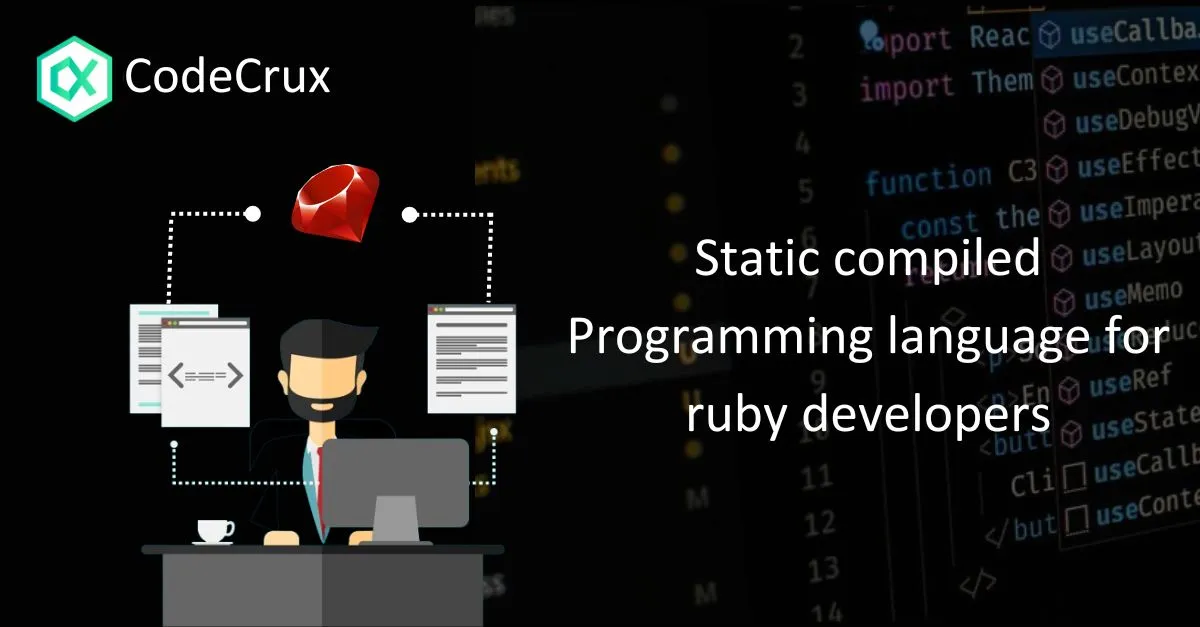
Static Compiled Programming Languages for Ruby Developers
Ruby has long been celebrated for its simplicity, expressiveness, and developer-friendly syntax. However, as applications grow in size or require high performance, Ruby’s interpreted nature and runtime overhead can sometimes become a bottleneck. This has led many Ruby developers to explore statically compiled languages, which offer faster execution times, better resource efficiency, and stronger type safety.
In this blog, we’ll delve into why Ruby developers should consider static compiled languages, the core differences between Ruby and these languages, and the most suitable options available.
Why Consider Static Compiled Languages?
Ruby’s dynamism and flexibility are ideal for rapid development and prototyping, but static compiled languages offer advantages in areas Ruby sometimes falls short:
- Performance: Compiled languages are typically faster because the code is converted directly into machine code, avoiding runtime interpretation.
- Memory Efficiency: Statically compiled languages often provide better memory management, making them ideal for large-scale or resource-constrained applications.
- Type Safety: Static typing catches errors during compilation, reducing runtime bugs and improving code reliability.
- Concurrency and Parallelism: Languages like Rust and Go excel in concurrent execution, making them perfect for modern, multi-core systems.
- Deployment Ease: Compiled binaries are standalone, reducing dependency issues and simplifying deployment compared to Ruby’s environment setup.
Challenges for Ruby Developers Moving to Static Compiled Languages
Transitioning from Ruby to a static compiled language comes with a learning curve. Common challenges include:
- Syntax Adjustments: Ruby’s expressive, high-level syntax contrasts with the stricter, sometimes verbose syntax of compiled languages.
- Static Typing: Ruby developers accustomed to dynamic typing may initially find type annotations and strict type checks cumbersome.
- Tooling Differences: Unlike Ruby’s gems and Bundler, static languages have their package management ecosystems that require adaptation.
- Longer Feedback Loops: Compilation adds a step before execution, which can feel slow compared to Ruby’s instant feedback in development.
Best Static Compiled Languages for Ruby Developers
1. Crystal
- Why It’s Great for Ruby Developers:
Crystal is heavily inspired by Ruby, offering a similar syntax while being statically typed and compiled. - Features:
- Type inference, so you rarely need to annotate types explicitly.
- High performance due to LLVM-based compilation.
- Built-in concurrency using fibers.
- Use Cases: Web applications, CLI tools, and services requiring high performance.
- Example:
1 2 3 4
def greet(name : String) : String "Hello, #{name}!" end puts greet("Ruby Developer")
2. Go (Golang)
- Why It’s Great for Ruby Developers:
Go emphasizes simplicity and readability, much like Ruby, but with a focus on concurrency and performance. - Features:
- Built-in support for goroutines and channels for concurrency.
- Easy-to-learn syntax with a powerful standard library.
- Single binary compilation for easy deployment.
- Use Cases: Web servers, microservices, and network tools.
- Example:
1 2 3 4 5 6 7 8 9 10 11
package main import "fmt" func greet(name string) string { return "Hello, " + name + "!" } func main() { fmt.Println(greet("Ruby Developer")) }
3. Rust
- Why It’s Great for Ruby Developers:
Rust prioritizes safety, performance, and concurrency, making it ideal for systems programming. - Features:
- Memory safety without a garbage collector.
- Zero-cost abstractions for high performance.
- Excellent tooling, including
cargofor package management.
- Use Cases: Game development, embedded systems, and performance-critical applications.
- Example:
1 2 3 4 5 6 7
fn greet(name: &str) -> String { format!("Hello, {}!", name) } fn main() { println!("{}", greet("Ruby Developer")); }
4. C++
- Why It’s Great for Ruby Developers:
While more complex, C++ is a powerful language for developers who need granular control over hardware and memory. - Features:
- Mature ecosystem with extensive libraries.
- High-level abstractions alongside low-level control.
- Backward compatibility with C for system-level programming.
- Use Cases: Game engines, high-frequency trading systems, and operating systems.
- Example:
1 2 3 4 5 6 7 8 9 10 11
#include <iostream> using namespace std; string greet(string name) { return "Hello, " + name + "!"; } int main() { cout << greet("Ruby Developer") << endl; return 0; }
5. Kotlin Native
- Why It’s Great for Ruby Developers:
Kotlin Native allows for building cross-platform applications with modern syntax and strong typing. - Features:
- Seamless integration with Java libraries.
- Null safety to avoid null pointer exceptions.
- Target native platforms without a JVM.
- Use Cases: Cross-platform apps, backend services, and mobile development.
- Example:
1 2 3 4 5 6 7
fun greet(name: String): String { return "Hello, $name!" } fun main() { println(greet("Ruby Developer")) }
How to Transition to Static Compiled Languages
- Start Small: Experiment with basic projects like CLI tools to understand syntax and paradigms.
- Leverage Familiarity: Start with languages like Crystal, which closely resemble Ruby.
- Utilize Resources: Tutorials, online courses, and community forums can accelerate learning.
- Practice Type Annotations: Begin using static typing concepts in Ruby with gems like
dry-typesorSorbetto prepare for the transition.
When Should Ruby Developers Use Static Compiled Languages?
- Performance-Intensive Applications: For tasks like real-time processing, high-performance servers, or game engines.
- Memory-Constrained Environments: Embedded systems or IoT applications.
- Scalable Systems: Applications that need to handle high concurrency or parallelism.
- Long-Term Projects: Where maintainability and type safety are critical.
Conclusion
Static compiled languages bring robustness, efficiency, and scalability, making them valuable additions to a Ruby developer’s toolbox. By choosing a language that aligns with your project’s requirements and learning preferences, you can create high-performance applications while retaining the developer-friendly ethos that drew you to Ruby in the first place.
Which static compiled language are you excited to try? Share your thoughts in the comments below!
